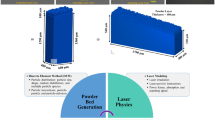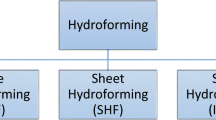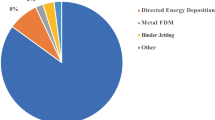Abstract
The gloss defect on a glossy surface is one of the surface defects to be found on injection-molded products. In this paper, the effects of the filling and packing stages on surface gloss are investigated. Based on observations, a generation mechanism of gloss difference is proposed. The difference of the surface gloss can be explained by the replication of the shrinking polymer surface represented by a replication factor. The replication factor is the ratio of melt pressure to surface stiffness, which is influenced by the filling condition and the material properties. The melt pressure as a driving factor to the replication reflects the effect of the flow front speed and viscosity. The surface stiffness as a resisting factor reflects the effect of the flow front speed, mold temperature in the filling stage, and storage modulus. The replication factor shows a high correlation to the surface gloss over a wide range of filling conditions. The proposed mechanism recommends a uniform and high flow front speed and mold temperature to suppress gloss defects.
Similar content being viewed by others
References
Agassant, J.F., P. Avenas, P.J. Carreau, B. Vergnes, and M. Vincent, 2017, Polymer Processing: Principles and Modeling, 2nd ed., Hanser Publications, Cincinnati.
Alexander-Katz, R. and R.G. Barrera, 1998, Surface correlation effects on gloss, J. Polym. Sci. Pt. B-Polym. Phys. 36, 1321–1334.
American Society for Testing and Materials—ASTM, 2003, ASTM D2457-03: Standard test method for specular gloss of plastic films and solid plastics, Annual Book of ASTM Standards, 08.01, ASTM International, West Conshohocken.
American Society for Testing and Materials—ASTM, 2004, ASTM D4449-90: Standard test method for visual evaluation of gloss differences between surfaces of similar appearance, Annual Book of ASTM Standards, 06.01, ASTM International, West Conshohocken.
American Society for Testing and Materials—ASTM, 2008, ASTM D523-08: Standard test method for specular gloss, Annual Book of ASTM Standards, 06.01, ASTM International, West Conshohocken.
Autodesk Pty. Ltd., 2019, Moldflow Material Database.
Bae, J.E., K.S. Cho, K.H. Seo, and D.G. Kang, 2011, Application of geometric algorithm of time-temperature superposition to linear viscoelasticity of rubber compounds, Korea-Aust. Rheol. J. 23, 81–87.
Berger, G.R., D.P. Gruber, W. Friesenbichler, C. Teichert, and M. Burgsteiner, 2011, Replication of stochastic and geometric micro structures — Aspects of visual appearance, Int. Polym. Process. 26, 313–322.
Bott, J., 2012, Do you still get stubborn surface defects, even with sequential valve gating?, Plast. Technol. 58, 26–27.
Carslaw, H.S. and J.C. Jaeger, 1959, Conduction of Heat in Solids, 2nd ed., Oxford University Press, Oxford.
Cross, M.M., 1965, Rheology of non-Newtonian fluids: A new flow equation for pseudoplastic systems, J. Colloid Interface Sci. 20, 417–437.
Ferry, J.D., 1980, Viscoelastic Properties of Polymers, Wiley, New York.
Gim, J., B. Kim, B. Rhee, J. Choi, S. An, and K. Jung, 2018, Valve gate open lag time in conventional hot runner system, Proc. ANTEC2018, Orlando, USA.
Gim, J., J. Tae, J. Jeon, E. Han, B. Kim, and B. Rhee, 2015a, The real-time determination algorithm of mold temperature stabilization, Proc. ANTEC2015, Orlando, USA.
Gim, J.-S., J.-S. Tae, J.-H. Jeon, J.-H. Choi, and B.-O. Rhee, 2015b, Detection method of filling imbalance in a multi-cavity mold for small lens, Int. J. Precis. Eng. Manuf. 16, 531–535.
Goodship, V., 2004a, Practical Guide to Injection Moulding, Rapra Technology Limited, Shropshire.
Goodship, V., 2004b, Troubleshooting Injection Moulding, 15, Rapra Technology Limited, Shropshire.
Gruber, D.P., M. Buder-Stroisznigg, G. Wallner, B. Strauss, L. Jandel, and R.W. Lang, 2008, A novel methodology for the evaluation of distinctness of image of glossy surfaces, Prog. Org. Coat. 63, 377–381.
Hong, S., J. Hwang, J. Kang, and K. Yoon, 2015, Comparison of injection molding and injection/compression molding for the replication of microstructure, Korea-Aust. Rheol. J. 27, 309–317.
International Organization for Standardization, 2014, ISO 2813: 2014(E) Paints and varnishes — Determination of gloss value at 20 degrees, 60 degrees and 85 degrees.
Jeon, J., M. Kim, B. Rhee, J. Chio, E. Park, and K. Jung, 2017, A study on the halo surface defect of injection molded products, Proc. ANTEC2017, Anaheim, USA.
Lednický, F. and Z. Pelzbauer, 1986, Gloss as an inner morphology characteristic of ABS polymers, Macromol. Mater. Eng. 141, 151–160.
Lee, J. and L.S. Turng, 2010, Improving surface quality of micro-cellular injection molded parts through mold surface temperature manipulation with thin film insulation, Polym. Eng. Sci. 50, 1281–1289.
Lee, J., L.S. Turng, E. Dougherty, and P. Gorton, 2011, A novel method for improving the surface quality of microcellular injection molded parts, Polymer 52, 1436–1446.
Li, J., T. Li, Y. Jia, S. Yang, S. Jiang, and L.S. Turng, 2018, Modeling and characterization of crystallization during rapid heat cycle molding, Polym. Test 71, 182–191.
Li, X.P., G.Q. Zhao, Y.J. Guan, and M.X. Ma, 2009, Optimal design of heating channels for rapid heating cycle injection mold based on response surface and genetic algorithm, Mater. Des. 30, 4317–4323.
Moon, J.S. and J.M. Lee, 2013, Shear viscosity measurement of highly filled polycarbonate melts using a slit-die rheometer, Korea-Aust. Rheol. J. 25, 129–135.
Ogilvy, J.A., 1991, Theory of Wave Scattering from Random Rough Surfaces, CRC Press, Bristol.
Oliveira, M.J., A.M. Brito, M.C. Costa, and M.F. Costa, 2006, Gloss and surface topography of ABS: A study on the influence of the injection molding parameters, Polym. Eng. Sci. 46, 1394–1401.
Shen, J.J., C.G. Li, H.T. Wu, and M. Kalantari, 2013, Fractional order viscoelasticity in characterization for atrial tissue, Korea-Aust. Rheol. J. 25, 87–93.
Simonsen, I., 2004, A random walk through surface scattering phenomena: Theory and phenomenology, arXiv:cond-mat/0408017.
Suhartono, E., H.S. Chiu, C.C. Hsu, C.C. Wang, C.W. Wang, and N. Pavan, 2017, Predict and solve stress mark on product’s cosmetic surface using controlled sequential valve gating simulation, Proc. ANTEC2017, Anaheim, USA.
Tae, J., J. Kim, J. Gim, H. Park, and B. Rhee, 2015, Evaluation of heat transfer conditions to the mold temperature stabilization in the injection molding process, Proc. ANTEC2013, Cincinnati, USA.
Tredoux, L., I. Satoh, and Y. Kurosaki, 2000, Investigation of wavelike flow marks in injection molding: A new hypothesis for the generation mechanism, Polym. Eng. Sci. 40, 2161–2174.
Wang, G., G. Zhao, H. Li, and Y. Guan, 2009, Research on a new variotherm injection molding technology and its application on the molding of a large LCD panel, Polym.-Plast. Technol. Eng. 48, 671–681.
Williams, M.L., R.F. Landel, and J.D. Ferry, 1955, The temperature dependence of relaxation mechanisms in amorphous polymers and other glass-forming liquids, J. Am. Chem. Soc. 77, 3701–3707.
Yang, S.S. and T.H. Kwon, 2007, A study of birefringence, residual stress and final shrinkage for precision injection molded parts, Korea-Aust. Rheol. J. 19, 191–199.
Yoshii, M., H. Kuramoto, T. Kawana, and K. Kato, 1996, The observation and origin of micro flow marks in the precision injection molding of polycarbonate, Polym. Eng. Sci. 36, 819–826.
Yuan, Z., D. Astbury, F.S. Costa, D. Ward, and M. Prey, 2015, Simulation and validation of mold filling with velocity controlled valve gates, Proc. ANTEC2015, Orlando, USA.
Yuan, Z., D. Ward, and M. Prey, 2014, Application and simulation of velocity-controlled valve gates, Autodesk University, Las Vegas, USA.
Zheng, R., R.I. Tanner, D.L. Wo, X.J. Fan, C. Hadinata, F.S. Costa, P.K. Kennedy, P. Zhu, and G. Edward, 2010, Modeling of flow-induced crystallization of colored polypropylene in injection molding, Korea-Aust. Rheol. J. 22, 151–162.
Acknowledgements
This work was supported by the National Research Foundation of Korea (NRF) grant funded by the Korea government (MSIT) (No. NRF-2018R1A5A1024127), and partially supported by the Erasmus+ international mobility grant (KA107) of the European Commission. The authors thank LG Chem Ltd., Republic of Korea for the supply of material. The first author would like to sincerely thank Univ.-Prof. Dipl.-Ing. Dr.mont. Walter Friesenbichler of Montanuniversität Leoben, Austria and Assoc. Prof. Dr. Dieter P. Gruber of Polymer Competence Center Leoben GmbH, Austria for their valuable support in this research and the opportunity to research in Austria.
Author information
Authors and Affiliations
Corresponding author
Additional information
Publisher’s Note
Springer Nature remains neutral with regard to jurisdictional claims in published maps and institutional affiliations.
Rights and permissions
About this article
Cite this article
Gim, J., Rhee, B. Generation mechanism of gloss defect for high-glossy injection-molded surface. Korea-Aust. Rheol. J. 32, 183–194 (2020). https://doi.org/10.1007/s13367-020-0018-1
Received:
Revised:
Accepted:
Published:
Issue Date:
DOI: https://doi.org/10.1007/s13367-020-0018-1




